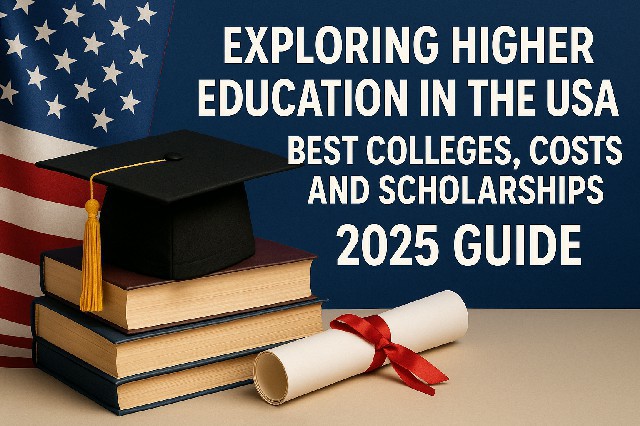Introduction Higher education in the United States has long been a beacon for students worldwide. With its diverse institutions, innovative programs, and vibrant campus cultures, the U.S. continues to attract aspiring scholars in 2025. This guide explores the best colleges, costs of attendance, available scholarships, and practical tips for navigating the higher education landscape in the United States.
Overview of Higher Education in the USA The U.S. higher education system is renowned for its flexibility, variety, and commitment to research. It includes community colleges, four-year colleges, public and private universities, and specialized institutions. The system encourages a broad curriculum and allows students to explore various fields before declaring a major. Community colleges offer two-year associate degrees and certificates and often serve as a stepping stone to four-year universities. Public universities are funded by
state governments, offering lower tuition to in-state residents. Private universities are funded through tuition, donations, and endowments and often have more financial aid resources. Liberal arts colleges focus on undergraduate education in the arts and sciences. U.S. institutions operate on a semester or quarter system, typically requiring 120-130 credit hours for a bachelor’s degree. Graduate education includes master’s and doctoral programs with varying credit and thesis requirements.
Best Colleges in the USA (2025 Rankings) According to the 2025 rankings from U.S. News & World Report and QS World University Rankings, some of the top institutions include Massachusetts Institute of Technology (MIT), Stanford University, Harvard University, California Institute of Technology (Caltech), and University of Chicago. Among top liberal arts colleges are Williams College, Amherst College, Swarthmore College, Pomona College, and Bowdoin College. The best public universities include University of California, Berkeley (UC Berkeley), University of Michigan, Ann Arbor, University of North Carolina at Chapel Hill, University of California, Los Angeles (UCLA), and University of Virginia. Each of these institutions offers a unique blend of academic rigor, campus life, and career opportunities.
Cost of Higher Education in the USA The cost of attending college in the U.S. can vary significantly depending on the institution and the student’s residency status. Community colleges typically cost between $3,000 and $5,000 per year. Public universities charge $10,000 to $15,000 per year for in-state residents and $25,000 to $35,000 for out-of-state students. Private universities may charge between $40,000 and $60,000 per year. Additional expenses include room and board ($10,000 – $15,000), books and supplies ($1,200 – $2,000), and personal expenses and transportation ($2,000 – $3,000). The total annual cost can range from $20,000 to over $75,000.
Scholarships and Financial Aid Fortunately, numerous scholarships and financial aid options help make higher education accessible. The FAFSA (Free Application for Federal Student Aid) determines eligibility for federal grants, loans, and work-study programs. Pell Grants are available for undergraduate students with exceptional financial need. Many states and colleges offer merit- and need-based aid, so it’s important to check individual school websites. Private scholarships, such as Coca-Cola Scholars, Gates Millennium Scholars, and the Jack Kent Cooke Foundation, are also available. Use databases like Fastweb, College Board Scholarship Search, and Scholarship.com. Many institutions offer scholarships specifically for international students based on academic merit or financial need.
Application Process Standardized tests such as the SAT or ACT (many schools are test-optional in 2025) and TOEFL or IELTS for non-native English speakers are often required. Common application platforms include the Common App, Coalition App, and school-specific portals. Key components of applications include a personal statement or essay, letters of recommendation, high school transcripts, and a resume or list of extracurricular activities. Deadlines typically include Early Decision or Early Action in November, Regular Decision from January to March, and Rolling Admissions which varies by institution.
Tips for Choosing the Right College Consider your academic interests, career objectives, campus culture, and size. Visit campuses or attend virtual tours to assess the environment and facilities. Evaluate the financial fit by comparing total costs and aid packages. Connect with current students or alumni to gain insight into student life and academic support.
Student Life and Support Services U.S. colleges provide a wide range of services including academic advising, career services, health and counseling centers, clubs and student organizations, and cultural and diversity offices. Campuses emphasize holistic development, offering opportunities in athletics, arts, leadership, and volunteer work.
Trends in U.S. Higher Education (2025) There is a notable growth in online and hybrid learning post-pandemic. Institutions are investing more in diversity, equity, and inclusion (DEI) initiatives to foster inclusive environments. There is also enhanced support for mental health and a growing emphasis on practical skills, internships, and job readiness within curriculums.
Conclusion Exploring higher education in the United States in 2025 involves a combination of research, planning, and self-assessment. With a range of institutions, ample financial aid opportunities, and a commitment to innovation, the U.S. remains one of the best destinations for academic and personal growth. Whether you’re aiming for a prestigious university or a community college, the right path is out there—one that matches your aspirations, needs, and potential. This guide aims to be your first step toward making informed decisions about your educational future in the United States. Good luck!
